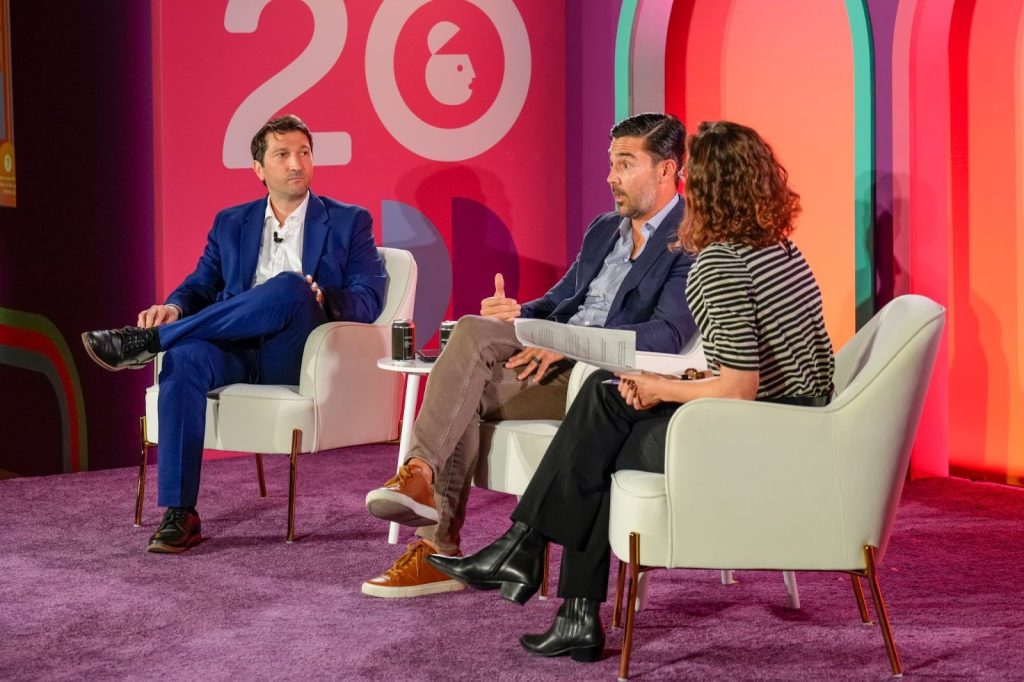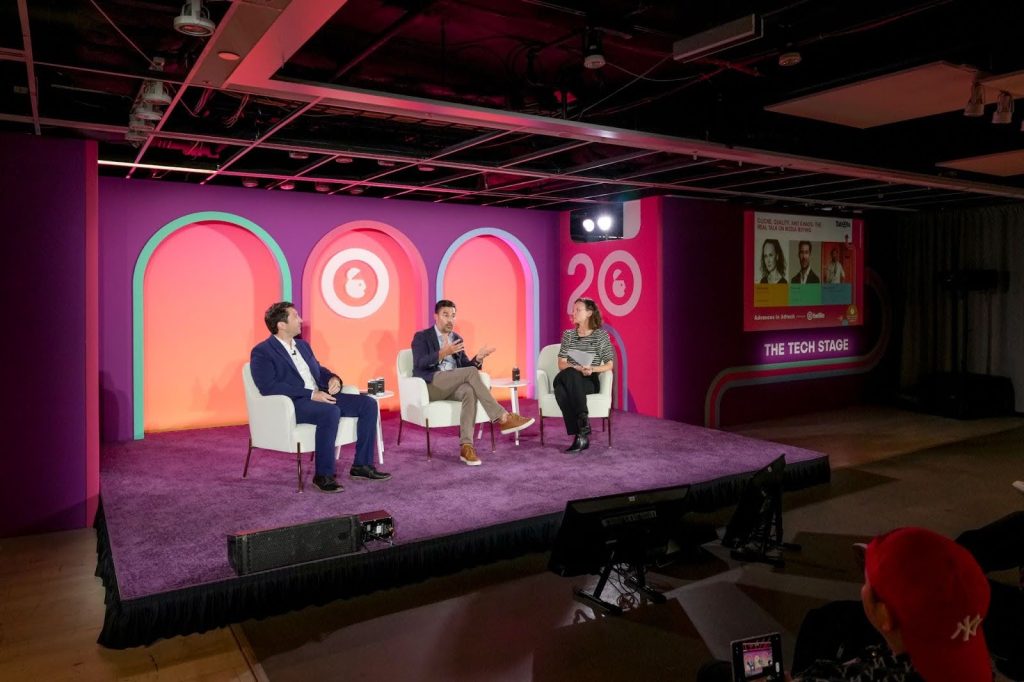Advertising Week by Shutterstock
A seemingly unending list of platform choices and advertising methods has led to a chaotic media buying ecosystem. While choice is appreciated, clarity and transparency have become rare commodities, leaving advertisers to grapple with questions about where their ads appear, the quality of the content surrounding ad placements, and the effectiveness of campaigns.
These issues were the focus of a recent panel discussion at Advertising Week New York called Clicks, Quality, and Chaos: The Real Talk on Media Buying. Host Katie Ingram, Director of Europe at Advertising Week, sat down with industry experts Vincent Meyer, Head of Strategic Partnerships at Taboola, and Chris Kane, Founder and President of Jounce Media, as they shared their perspectives on the state of the industry and offered tangible advice to advertisers who want to reclaim control and extract the most value from their ad spend.
Check out the key takeaways below, or watch the whole discussion if you don’t want to miss a thing!
MFA Websites and The ‘Gotcha’ Moment
To set the stage for the discussion, Katie asked Chris to provide a brief overview of Made for Advertising (MFA) websites, which have become controversial in the industry.
As Kane explained, “There are news sites, and there are MFA sites. MFA websites generate a bunch of vanity metrics like high ad viewability, low detected bot traffic, brand-safe content, high video completion rates, and low CPMs, but they don’t drive sales.”
Knowing that brands want to be surrounded by valuable, premium content and engage with genuine users, Katie asked how advertisers can identify and avoid these low-quality sites.
Vince emphasized the importance of transparency in addressing this concern. “At Taboola, we want to explain what our portfolio looks like. We represent many publishers and want to put that in front of advertisers.” That approach and conversations about what brands should and shouldn’t be doing prevent the ‘gotcha moment,’ which happens when brands feel that they have been duped.
Chris elaborated on the idea of the ‘gotcha moment,’ explaining that recent research has made the industry question whether MFA supply was beneficial or detrimental. When it became clear that buyers didn’t want this supply, the sell side was prepared to react. He said, “The broader lesson is that buyers need to be clear about what they want, and the sell side will respond.”
Tracking Traffic Sources to MFA Sites
Katie then turned to Chris to discuss Jounce Media’s methodology to identify which platform players drive traffic to these sites.
Through the company’s research, it became evident that Facebook is the lifeblood of these sites. Kane described the situation bluntly: “If any other traffic source stopped sending traffic to MFA publishers, nothing would change. If Facebook decided not to send any more traffic to content arbitrage, this publisher category evaporates.”
Vincent thinks the real issue is that marketers are often unaware their ads are running on these sites. He mentioned Taboola has minimal representation because the quick arbitrage model MFA sites use, showing up to 50 ads in a minute or two to maximize profits, isn’t compatible with Taboola’s experience or ad structure. Recognizing that incompatibility allowed Taboola to create its Taboola Select Solution, which ensures ads appear only on MFA-free sites.

Balancing Quality and Scale
Shifting topics slightly, Katie posed her next question, “Brands are looking for both quality and scale, but it’s hard to strike the right balance. How can platforms, measurement companies, and agencies get that scale without the risk of losing genuine user engagement?”
Vincent acknowledged that that’s a hard thing to do. He suggested instead of being concerned with metrics, advertisers should focus on the goal of campaigns. He gave an example to illustrate why vanity metrics don’t matter, saying, “If I sell shoes, my goal is not to have high viewability. It’s to sell shoes.”
In Chris’s experience, every media campaign must balance competing incentives: inventory from trusted publishers, KPIs, and budget. Unfortunately, “when one thing has to give, it’s not the KPIs or budget.” Chris mentioned that during private conversations, some agencies and brands choose to “just buy what’s going to hit the KPIs” because even though the metrics are flawed, they are still seen as a demonstration of success.
Shifting Strategies and Relying on Data
Katie brought the discussion back to the event’s title with her next question: “With so many platforms, inventory types, and other aspects, how can advertisers successfully navigate through such a complex environment, and how do third-party measurement providers help cut through the chaos?”
Chris believes media teams that care about brand safety and KPIs will continue to work with verification companies. However, he emphasized that this approach should be complemented by human oversight that creates boundaries around which publishers’ or trusted portfolios’ supply should be bought.
Vincent cautioned against limiting partnerships to only a few trusted publisher groups, explaining that Taboola works with thousands of small and medium-sized publishers who offer excellent opportunities to connect with local communities. Not working with those publishers amounts to missed audiences.
He thinks tools should make information and data points more visible and that platforms such as Taboola have a responsibility to help foster trust between advertisers and publishers.

Rebuilding Trust in the Open Web
The issue of trust has been a recurring theme in digital advertising, so Katie asked how the open web can build more trust with brands and agencies.
Vincent admitted that trust on the open web has been broken and that platforms and publishers have to do much more to fix this, however, he questioned why advertisers still trust walled gardens that offer no transparency, reports, or data. Regardless of the rationale, he believes trust can be rebuilt through open conversations about advertiser expectations and collaborating with publishers to develop experiences that can meet them.
Chris added that small publishers already recognize they don’t have the resources to build and manage trusted relationships with the buy side, so they outsource that work. Mid-market publishers need to reach the same conclusion because if they don’t start working with trusted partners, their supply will become irrelevant.
Advancing Transparency and Accountability in Media
This conversation highlights that most companies share a common vision for open web media: fostering greater transparency and collaboration to ensure all parties are aligned on their goals. By moving beyond “gotcha” moments, advertisers and publishers can focus on creating real value and showcasing the unique contributions of publishers. With the support of third-party data, advertisers now have the tools to validate campaign performance confidently, scaling their efforts in a brand-safe environment that champions quality content from journalists, creators, and diverse entertainment sources.